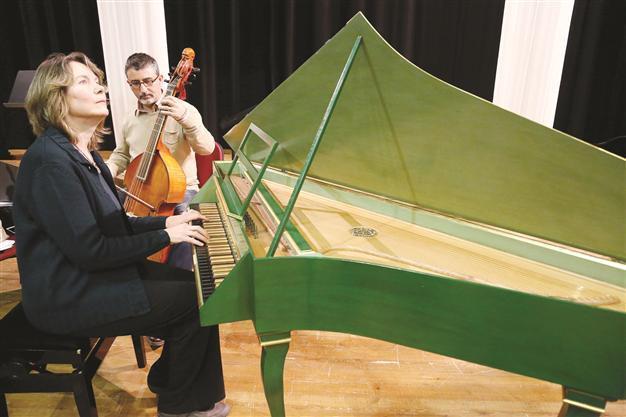Turkish ensemble brings Baroque era music to world stage
İZMİR - Anadolu Agency

İzmir Barok has performed many concerts in Turkey and abroad giving music lovers an opportunity to listen to European and Ottoman palace music with instruments of the time. AA photos
Turkey’s first baroque ensemble, İzmir Barok, which was formed in 2008 by the İzmir State Opera and Ballet contra bass artist Bülent Oral and violin artist Hakan Özaytekin, gives music lovers an opportunity to listen to European and Ottoman palace music with instruments of the time.The ensemble keeps the Baroque period, which appeared in the 16th century and continued until the middle of the 18th century, alive with original instruments and the music style of time.
Using the cembalo (harpsichord), which is considered the ancestor of today’s piano, the violoncello and flute, viola da gamba and Braque flute in their original forms, İzmir Baroque brings this magnificent era of music history to the stage.
Oral said after the formation of the ensemble, they had started examining Ottoman palace music and began playing Ottoman instruments. “In this way, we have obtained a concept of performing both European and Ottoman music with the instruments and style of the baroque era,” he said.
Oral said the ensemble had performed many concerts in Turkey and abroad and also released an album titled “16. Yüzyıldan 18. Yüzyılın İlk Yarısına Avrupa ve Osmanlı Saray Müzikleri” (European and Ottoman Palace Music between the 16th and the first half of the 18th century).
Speaking about the album, Oral said the following about Baroque era European and Ottoman palace music: “European music has more ornamentation. The biggest difference is Ottoman music is monophonic. But we made it polyphonic in the harmony structure of the Baroque era. Without changing the main melody, we made a basis using the cembalo and viola da gamba, as well as Turkish music and European instruments. Of course all music cannot be played in this concept, but there are many composers who made it. We have a mission to introduce them to Europe.”
Concerts draw interest
He said they drew great interest in concerts, adding, “We have received very good reactions in concerts abroad. People know about Ottoman instruments and see the difference from European ones.” Both forms of music took shape in palace
Oral said what Baroque-era music in Europe and Ottoman music had in common was they were both born in the palace, adding palace life could be seen in this music.
The basic difference between the two forms of music, Oral said, was also born in this aspect. “The palace structures are very different from each other. This is the same for musicians, too. European palaces are always magnificent. This is the same for Ottoman palaces, but the music is more closed because it was made in the seraglio,” he said.
















